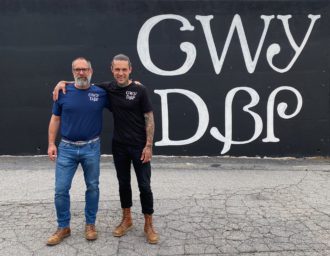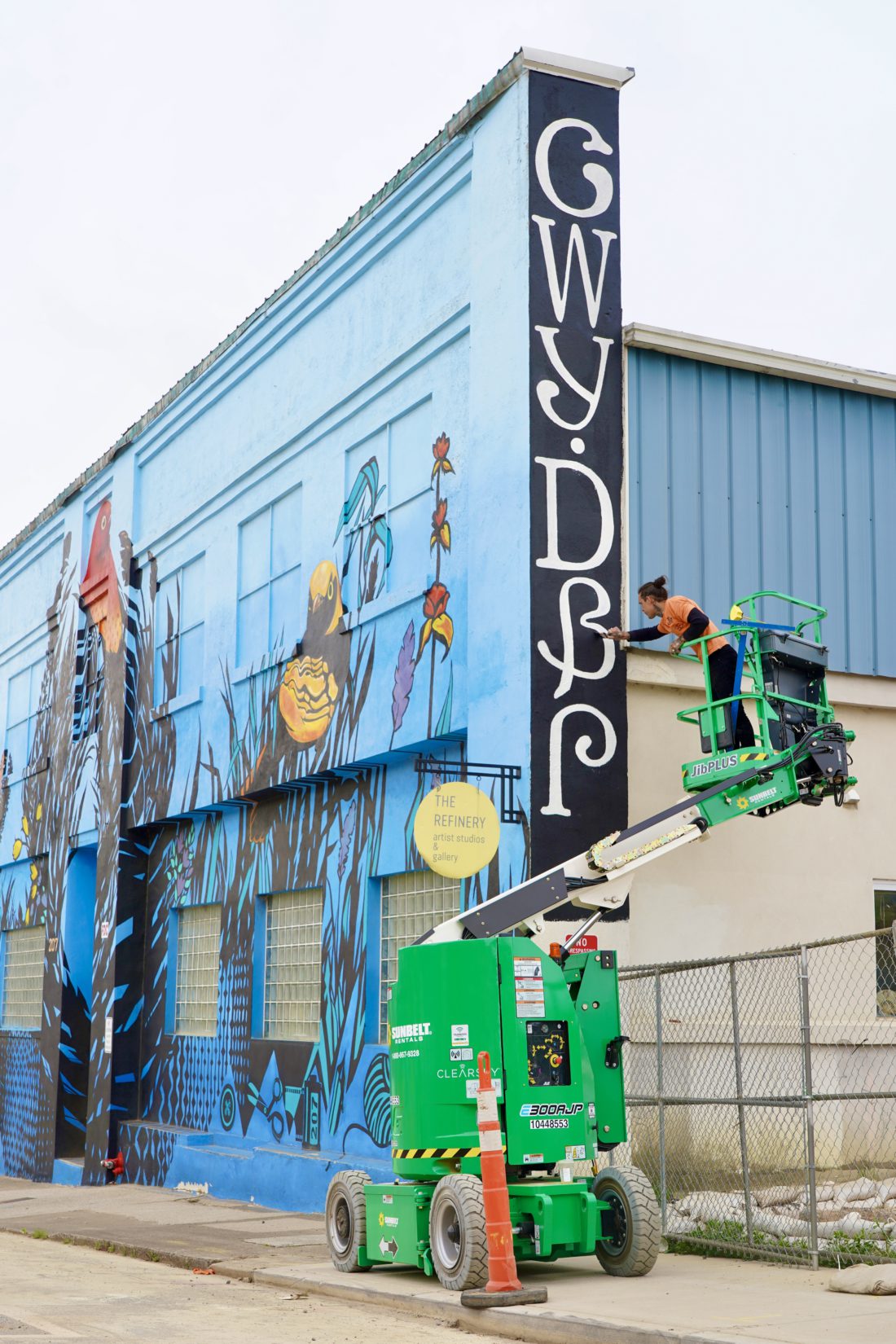On April 3, Jared Wheatley was 20 minutes into painting the first mural of the Indigenous Walls Project at 46 Aston St., when a young family of three approached him and inquired what he was doing.
“I’m like, ‘Oh, this is the Cherokee language.’ And the boy, who’s maybe 4 or 5, is like, ‘Cherokee language?’” says Wheatley, a dual citizen of the U.S. and the Cherokee Nation. “And the mom says, ‘Yeah! Actually, the Cherokee people used to own all of this.’ Before I could even step up and say anything, she started explaining to her son that there are people here that have always been here and been on the land.”
Through placing these public artworks in prominent parts of Asheville, Wheatley aims to stimulate similar conversations between Indigenous and non-Indigenous people on a broader level. In turn, he hopes to help raise awareness of a larger movement to reintroduce the Cherokee syllabary and language to its people, collaborate with members of the more than 500 Indigenous nations in the U.S. and fight against stigmas that continue to hamper Native Americans.
Family ties
Wheatley’s inspiration for the Indigenous Walls Project stems from his grandfather Robert Lee Whitmire’s time growing up in Tahlequah, Okla., which marks the end point of the Trail of Tears and the center of the Cherokee Nation.
“[My grandfather] spoke Cherokee, but at the Indian school he attended, they were known for beating children for speaking Cherokee,” Wheatley says. “He was a boarding student there, so he lived in that school and essentially unlearned the language and then didn’t pass it on to my mother [Brenda Lee Whitmire], who also subsequently didn’t pass it on to me.”
Adding to the family’s disconnect from their heritage were his grandfather’s experiences during what’s called the“termination era” (1953-70), when Congress resolved to terminate the special trustee relationship that Native American tribes held with the federal government. During that time, more than 100 tribes were terminated, and more than a million acres of land were removed from protected status.
A companion policy of relocation, via such initiatives as the 1952 Urban Relocation Program, encouraged Native Americans to move off reservations and into urban centers by framing it as a means of pursuing increased economic opportunities. Though not formally relocated under the URP, Wheatley’s grandfather moved in 1956 to Independence, Mo., where Wheatley was born in 1985.
“I’m what’s known as an ‘Urban Indian,’” he says. “And I’m very comfortable with the word ‘Indian.’”
Now based in Asheville and the owner of Wheatley Construction and Épatage Workwear, Wheatley has felt called to action by recent efforts of the three recognized tribes of the Cherokee Nation to resuscitate their dying language. He and his 12-year-old daughter, Alexis, are studying Cherokee and will begin taking courses during her summer break from school.
“It’s very personal and honestly complex, because what people in Asheville know about Indigenous people and Native Americans is the Eastern Band of Cherokee Indians,” Wheatley says. “However, that’s not my nation. While I’m brothers with that tribe, I’m not actually of that tribe. So for me, the project is about raising awareness of all Indigenous tribes.”
Asheville alliance
Without David Moritz, managing partner for the Asheville-based real estate private equity investment firm East West Capital, Wheatley doubts that the Indigenous Walls Project would exist. Upon learning of Wheatley’s vision, Moritz says he felt an immediate desire to be an ally of the project and community, and granted Wheatley permission to paint the walls of any local building that Moritz owns — several of which are in the bustling South Slope brewing district.
“What I love about the project is that it brings awareness to the history and culture of Indigenous people in a very public and accessible way,” Moritz says. “The platform allows anyone living in or visiting Asheville exposure to the Cherokee syllabary and soon other Indigenous nations’ art and language. Providing physical space for Indigenous murals is a first step in establishing mental space so that we can all become more knowledgeable about Native American history.”
Galvanizing Moritz’s commitment to the Indigenous Walls Project is his Jewish heritage and his father’s experience as a Holocaust survivor. The elder Moritz fled Becherbach, Germany, in November 1938 after the Night of Broken Glass (“Kristallnacht”) at the age of 8. He then hid in France under the alias Alfred Mauricet with forged papers provided by OSE, an organization established to save Jewish children. He was saved in 1944 when the U.S. Army liberated France. The elder Moritz reunited with his parents, who survived by hiding in a mental hospital. The family remained in France as refugees without a country until 1948, when they were able to emigrate to Chicago.

“He would always say that he was persecuted simply for being different, and I think that made me empathetic to the plight of the persecuted and also a lifelong student of history,” Moritz says. “Jared’s project touched a nerve in me that wants to help the persecuted have a voice and make sure that their history is not forgotten. It’s important that we remember what happened, and it’s important that we have a conversation about it, especially if it means that the atrocities of the Holocaust or the Trail of Tears or any type of genocide are not repeated again.”
Moritz finds Wheatley’s murals at 46 Aston St. and 207 and 217 Coxe Ave. “at once striking but also simple and effective.” Each painting uses six letters of the Cherokee syllabary to spell out “Cherokee Nation.” But whereas the formal title for “Cherokee” has four letters, Wheatley opted for a slang spelling that he says is more representative of youth culture.
“Our approach is very future-focused — not reflecting so much on the past,” Wheatley says. “Part of Native culture is a tradition of planning for seven generations ahead, so part of that is what our language looks like into the future for my kids and my kids’ kids.”
Forward motion
That multigenerational mindset will be further put into practice Friday, May 6-Sunday, May 8, when Wheatley joins forces with his mother and daughter on a larger mural next to his initial 46 Aston St. syllabary painting. The two women are creating the design together and in doing so will carry on a family legacy.
“I’m really lucky to have an artistic family,” Wheatley says. “And to go full circle, my mom actually did murals throughout my entire elementary school, up and down the hallway; so when I went to school, I was surrounded by my mother’s art.
“Part of why I particularly want my family to paint one of the walls adjacent to my first mural is because that’s the way love and care have been expressed to me through my life,” Wheatley continues.
Wheatley is also currently coordinating with six separate nations based in Minnesota, Wisconsin, Kansas, Oklahoma and Florida to travel to Asheville to paint. Future goals for the project include live painting events with multiple nations and connecting with local tour guides to include the murals on their routes. But topping the list is a permanent mural installation in Asheville that would serve as an epicenter for the conversation of Indigenous arts.
“Indigenous people are not a monolith. We’re not one single thing that you can point to and say that we’re stagnant and that we only do beadwork or we only do paintings or we only do leatherwork,” he says. “We have an opportunity as a people to craft our own culture every day, and that’s a conversation that’s important for broader society to understand, particularly when it comes to Indian rights and Indian law. Unfortunately, the conversation is often shaped around the idea that Indians are a monolith and their culture can be understood, and it’s more complex than that.”
To learn more, visit avl.mx/bjd




Before you comment
The comments section is here to provide a platform for civil dialogue on the issues we face together as a local community. Xpress is committed to offering this platform for all voices, but when the tone of the discussion gets nasty or strays off topic, we believe many people choose not to participate. Xpress editors are determined to moderate comments to ensure a constructive interchange is maintained. All comments judged not to be in keeping with the spirit of civil discourse will be removed and repeat violators will be banned. See here for our terms of service. Thank you for being part of this effort to promote respectful discussion.